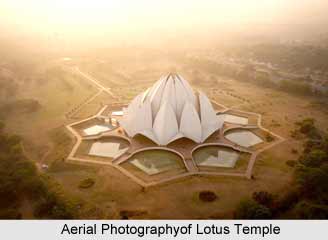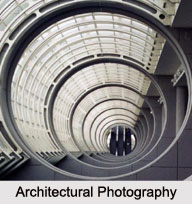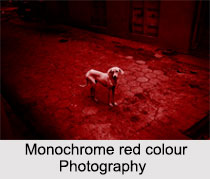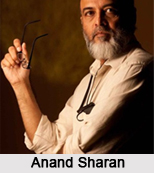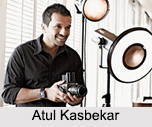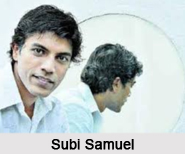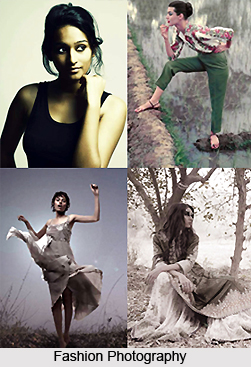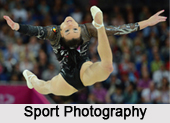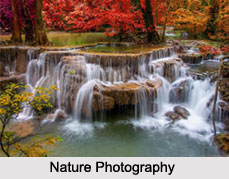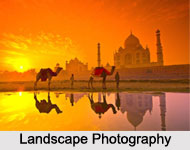`Art should strip life to form`- Robert Frost
`I remember my first shot as a photographer, in 1938. A group of women from the Women`s Club in Bombay had gone for a picnic party and I photographed them. My first published pictures were in the Bombay Chronicle a whole range of pictures, for which I was paid one rupee in cash for each`- Homai Vyarawalla.
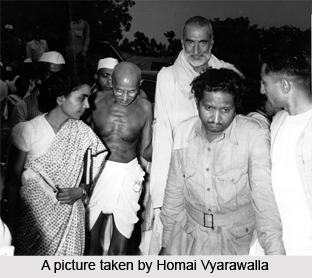 Indian women from the upper middle class section of the society started taking interest in photography after 1910. Among early female photographers of India were Mira Chaudhuri (1905-1994), Indira Dey (1912-1992), Manobina Roy (1919-2001), Debalina Mazumadar (1919) and Rajendra Kunverba (1920-2000). The most notable name is that of Homai Vyarawalla, India`s first woman press photographer who later developed as an extraordinary photojournalist. Homai was born in Navsari, a Mafussil town in Gujarat. Her father was an actor from the Urdu-Parsi theatre. The family was poor and her parents packed her off to Bombay for further school and college studies. Homai took an Honours degree from Bombay University and a Diploma in Art from J J School of Art. As a very young woman, she fell in love with another photographer called Maneckshaw and married him. She lived happily ever thereafter. Maneckshaw had a tremendous influence on Homai as a photographer. In the early days Homai would take photographs and her husband Maneckshaw would spend hours in the dark room at home to get the right colours. In the field of photography and photojournalism Homai and Maneckshaw complemented and supplemented each other.
Indian women from the upper middle class section of the society started taking interest in photography after 1910. Among early female photographers of India were Mira Chaudhuri (1905-1994), Indira Dey (1912-1992), Manobina Roy (1919-2001), Debalina Mazumadar (1919) and Rajendra Kunverba (1920-2000). The most notable name is that of Homai Vyarawalla, India`s first woman press photographer who later developed as an extraordinary photojournalist. Homai was born in Navsari, a Mafussil town in Gujarat. Her father was an actor from the Urdu-Parsi theatre. The family was poor and her parents packed her off to Bombay for further school and college studies. Homai took an Honours degree from Bombay University and a Diploma in Art from J J School of Art. As a very young woman, she fell in love with another photographer called Maneckshaw and married him. She lived happily ever thereafter. Maneckshaw had a tremendous influence on Homai as a photographer. In the early days Homai would take photographs and her husband Maneckshaw would spend hours in the dark room at home to get the right colours. In the field of photography and photojournalism Homai and Maneckshaw complemented and supplemented each other.
Homai started freelancing for the Illustrated Weekly of India. And its editor Stanley Jepson used to give her weekly assignments. In the early days for a fragile woman like Homai taking photographs in field situations was not easy. Her large-format Speed Graphic camera had a composite wood, steel and aluminum chassis, which used to weigh more than six pounds. In the world of photojournalism, Homai Vyarawalla came out with great photographs starting from 1938 for over a period of 35 years till 1973. Homai Vyarawalla was a great creator of photographic art in our country. Though the creative world of her works of art sprang from life, yet at the same time it represented a unique world of its own, serenely detached from the surrounding cauldron of clutter, clatter and confusion. Consequently her works of photographic art have preserved for posterity a beautiful slice of life that might otherwise have been dissolved in the constant flux and flow of reality in the never-ending river of time.
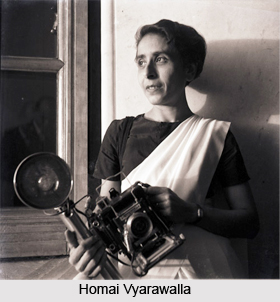 When Homai Vyarawalla dressed in an elegant Indian sari and armed with a Rolliflex camera, was hopping from place to place in the centres and corridors of power from 1945 to the late 1960`s, she had the unique opportunity, normally given to very few press photographers, of catching on the camera great historical events and personalities ranging from Lord Mountbatten to Marshall Tito, from Queen Elizabeth to Jacqueline Kennedy, from Khrushchev to Kosygin, from Eisenhower to Nixon, apart from Atlee, Nasser, Chou En Lai and a host of others who have shaped the direction and contours of 20th century history. She took many delightful photographs of Nehru, Indira Gandhi and the other members of her family. Thus she herself became a part of history in the making, capturing World War II, India`s Freedom Struggle leading up to independence and subsequently the hectic days of Jawaharlal Nehru and Indira Gandhi.
When Homai Vyarawalla dressed in an elegant Indian sari and armed with a Rolliflex camera, was hopping from place to place in the centres and corridors of power from 1945 to the late 1960`s, she had the unique opportunity, normally given to very few press photographers, of catching on the camera great historical events and personalities ranging from Lord Mountbatten to Marshall Tito, from Queen Elizabeth to Jacqueline Kennedy, from Khrushchev to Kosygin, from Eisenhower to Nixon, apart from Atlee, Nasser, Chou En Lai and a host of others who have shaped the direction and contours of 20th century history. She took many delightful photographs of Nehru, Indira Gandhi and the other members of her family. Thus she herself became a part of history in the making, capturing World War II, India`s Freedom Struggle leading up to independence and subsequently the hectic days of Jawaharlal Nehru and Indira Gandhi.
She is a thorough professional who keeps a distance from her subjects and refuses to be over-awed into hero-worshipping. This perhaps distinguishes her from the average photojournalist, who, given her fame and experience, would have been too willing to drop names and claim proximity with the great and mighty. She produced her great photographs in an effortless and exquisite manner, which always reflected and radiated the ecstatic quality of her soul.





